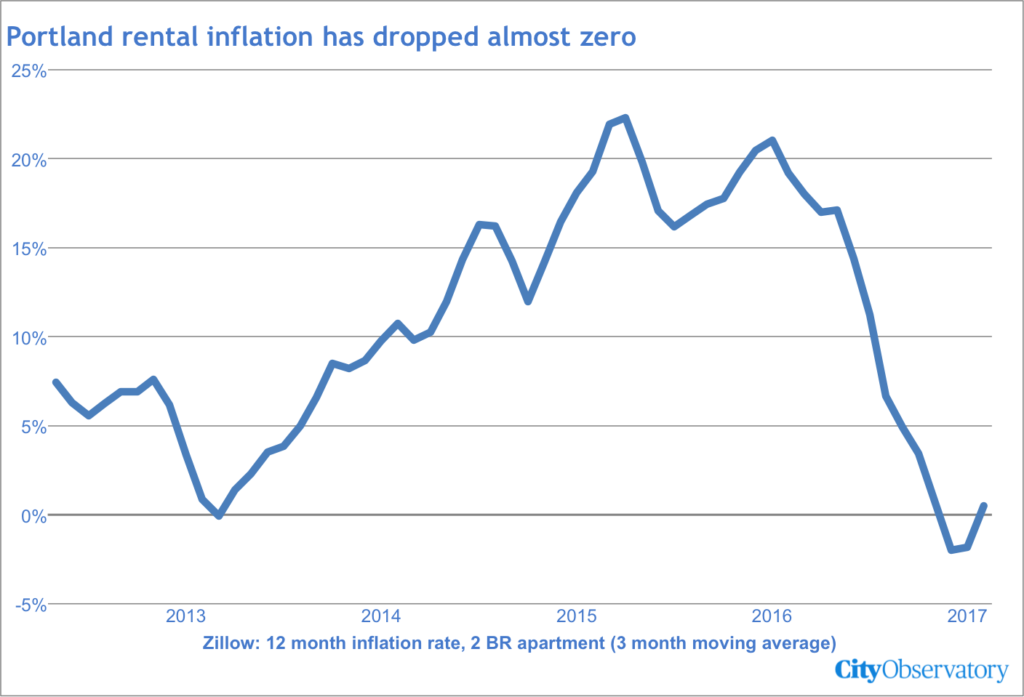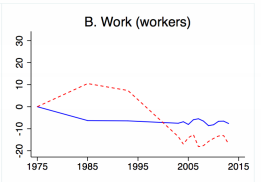What City Observatory did this week
1. Too soon to write off city revival? The release of the Census county-level population estimates two weeks ago led to a series of quick-reaction analyses of what the data portend for the “back-to-the-city” movement that’s been seen in the past several years. Unfortunately, county level data is a poor guide to understanding city population trends. And while it appears that city growth has moderated compared to the past year or two, cities are growing more rapidly than a decade ago, while suburbs are growing more slowly. In addition, we are likely reaching a point where city growth is constrained not by a diminished preference for urban living, but by the failure of supply to keep up with the growing demand for cities.
2. Has Portland’s rent fever broken? In early 2016, rents in Portland were growing at double-digit levels, prompting its City Council to enact one of the nation’s most demanding inclusionary zoning requirements. But over the past twelve months, new apartment supply has apparently been catching up with demand. According to data tabulated by ApartmentList.com and Zillow, rents in Portland have been flat over the past year, and the city has recorded some of the lowest levels of rental inflation of any large metro area in the US. Plus, there are thousands of more units in the construction pipeline, many of them motivated to get building permits before the new inclusionary zoning requirements kick in. More supply is likely to further moderate rents in Portland in the year ahead.

3. Why might Uber and Lyft support road pricing? In the past few months, key executives at the nations’ two largest transportation network companies have editorialized in favor of road pricing. At first glance, this seems odd, inasmuch as both firms would be among the biggest payers of such fees. But looking forward, there are good reasons to think that road pricing would spur further growth of their business models–as well as potentially improving the flow of traffic in cities.
Must read
1. Henry Grabar’s review of The New Urban Crisis. Richard Florida’s latest opus has hit the shelves, and while we’re still reading our copy at City Observatory, Slate’s Henry Grabar offers up his views. If you don’t have the book, there’s an excerpt at CityLab. Grabar’s key point: while Florida presents a good synthesis of the literature and data on growing income inequality and economic segregation within metro areas, his composite “urban crisis index” creates a mish-mash of cities with very different problems and characteristics. That, and November’s Trump victory seem to have quashed Florida’s (and everyone else’s) hope that national policies will take on a seriously city-centered approach to any of the nation’s most pressing problems. There’ll be more to discuss in the weeks ahead, but Grabar offers some useful questions to start the debate.
2. The Economist on Parkaggedon. The venerable London-based global newsmagazine the Economist channels its inner Donald Shoup in a long article and editorial making the case for better pricing parking. While there’s little new here for those who following parking closely, its a prominent and extremely well-argued case for reforming the way we think about parking. Bottom line: Don’t let people park for free.
3. Alon Levy debunks the vacuum tube. The hyperloop is generating a new round of hype in transportation circles. At Pedestrian Observations, Alon Levy does some basic fact checking on the cost assumptions and physics of building a system of pneumatic tubes to shoot people from city to city. He concludes that hyperloop advocates make some heroic (and unsubstantiated) assumptions about cost, and that a fawning and deferential press gives Elon Musk a pass on outrageous claims because he’s a wealthy techno-celebrity. Levy also points out that the lateral acceleration and g-forces that a hyperloop would create would make a roller-coaster ride tame by comparison.
New ideas
We’re spending less time traveling. While headline grabbing “cost of congestion” reports seem to paint a picture of ever increasing traffic and lengthening commutes, there’s another source of data about our travel habits that show a very different trend. A new paper from George Washington University’s Chao Wei and Chen Song compiles decades of time use data to examine travel behavior relative to other uses of time. The federal government has long surveyed American’s on their use of time, asking respondents to fill out time diaries that record all of their activities on given days. This source of data shows that actually, the amount of time that working Americans spend traveling to and from their jobs has actually decreased over the past couple of decades. The following chart shows the change in time spend working (the blue line) and the time spent traveling to and from work (the red dotted line) since 1975. While commuting time increased in the 1980s and 1990s, the time diary data suggest that commute times have declined since then, and are now 10 to 20 percent less than they were in 1975.

City Observatory in the news
More than just call centers. The Portland Business Journal looks at the way that software companies increasingly rely on ongoing relationships with their user base to continually refine and improve their products. As Joe Cortright explains, far from simply offering highly scripted hand-holding, the customer support function in many firms is a critical part of the product development and improvement process.

